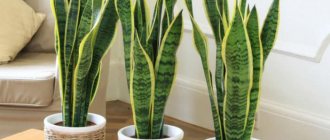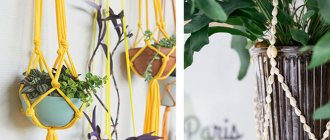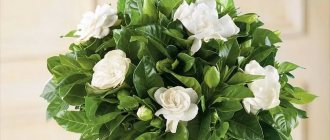Indoor plants have been used to decorate our homes since ancient times. They live in living rooms and bedrooms, children's rooms and offices. They also paid attention to the kitchen. Many housewives enjoy decorating their home with various representatives of the earth's flora. And yet, which flowers are preferable for the kitchen, how to choose the right plant and what needs to be taken into account.
The kitchen is a paradise for plants
Criteria for choosing colors for the kitchen
Today, when the shelves of flower shops are filled with all kinds of tropical exotics, choosing a plant for the kitchen is quite difficult. Not every representative of the earth's flora is able to withstand extreme kitchen conditions. Constant temperature changes, steam and grease splashes, and frequent ventilation are not good for many plants. What needs to be taken into account in order not to make a mistake when choosing indoor flowers for the kitchen?
The main selection criteria are:
- expected location of the plant
- the side facing the kitchen windows
- room dimensions
- personal preferences
- decorative value of a flower
Let's take a closer look at each factor to make the right choice.
The windowsill is a place where flowers in the kitchen do not disturb the housewife and feel great.
When determining a place for a flower, the first thing we pay attention to is the window sill. It’s great if it’s wide and you can place voluminous plants on it. In addition, this is the only place where flowers in the kitchen do not interfere with the housewife’s work and feel great. In addition, near the window they receive enough light for their proper development.
Depending on the side the windows face, light-loving or shade-loving plant species are selected.
Obviously, the dimensions of the room affect the number and size of flowers. It is unlikely that you will be able to place a tall ficus or Dieffenbachia, which loves space, in a small kitchen.
Personal preferences are important only for the hostess. When choosing a flower, she wants to receive both aesthetic and spiritual pleasure from being next to it.
Decorative value is related to the style of the interior. So, a delicate and touching violet looks great on the dining table, and a modest succulent is also suitable for decorating an open shelf.
Violet is great for the kitchen
Choosing the right place
In small rooms, live decorations are placed on the windowsill; violets and begonias will fit perfectly there. The use of lush flowers in such a place is impractical, as they will visually reduce the already small space. You can hang hanging pots on the window or walls, or place flowers on the top shelves of the kitchen unit. Ivy, asparagus and other climbing species are suitable for this purpose.
Plants that can withstand high temperatures are placed near the oven: asparagus and tradescantia, which are unpretentious to their environment.
If the kitchen area is spacious, then you can consider a variety of options. Firstly, large flowerpots are placed on the floor. Tall tree-like plants will look beautiful in them. Secondly, you can install floor stands with several holders, which will become the main element of the decor.
If you want to diversify the interior and give the kitchen space originality, then you can use this technique: instead of flowerpots, take unusual containers, for example, cups, old unnecessary teapots for brewing tea.
When choosing a place, you should take into account the nuance - plants decorate the kitchen and should not interfere with moving and working in it. Therefore, it is recommended to place flowerpots so that it is convenient to open the cabinet doors and they do not block the light from the window. For this reason, tall flower specimens will not be suitable, but medium or small ones will fit perfectly.
Conditions of detention
In order for the flowers in the kitchen to feel cozy and healthy, it is necessary to provide them with proper care. First of all, it is worth deciding where you can place plants, and where it is strictly not recommended.
- You cannot place flowers next to the sink. When washing dishes, cleaning products containing chemicals are used. Splashes fall on the plant, and it can get burned or die.
- You can't keep flowers near the stove. When cooking food, a greasy coating inevitably accumulates on them, which interferes with the normal respiration of the plant. It begins to suffocate, loses its beautiful appearance, gets sick and dies.
- The best place to place plants in the kitchen is a window sill, hanging shelves and flowerpots.
- It is possible to place flowers on the floor if the size of the kitchen allows this.
Important! When keeping flowers on a windowsill, try to protect them from drafts. When ventilating the room, take your pets to another room.
Plants in the kitchen need to be watered more often and wiped regularly.
If you decide to put a flower on the refrigerator or top shelf, get ready for the fact that it will need to be watered more often and wiped regularly. Hot air accumulates at the top, so the plant requires natural cooling and maintaining normal humidity.
Worst Plants
Plants that are best not to be placed in the kitchen:
- Succulents and cacti - they need low temperatures in winter, and the kitchen is quite hot at any time of the year;
- Flowers with pubescent leaves - the Gesneriaceae family, for example, Saintpaulia - cleaning them from dust and grease will be a problem;
- Plants that prefer low ambient temperatures - azalea, cyclamen;
- Poisonous plants - oleander, nightshade, adenium, some types of euphorbia - the juice of these flowers can cause allergies and burns, and if it enters the esophagus, it can cause poisoning.
Types of indoor plants for the kitchen
Now let’s go to the store and see what they offer us, and decide which flowers can be kept in the kitchen, taking into account the criteria described above.
If your kitchen windows face southwest, west or east, you can afford to place such demanding flowers as encyclia, mentholia, and phalaenopsis from the orchid family on the windowsill. This arrangement will also be well received by various types of succulents, including the beloved spurge. Azalea and passionflower, crotons and cacti, agave and cyclamen will take root here.
Demanding flowers from the Orchid family look great on the kitchen window
For north and northeast windows, choose plants that can tolerate shade. Dracaena, sansevieria, bamboo, various types of monstera, dieffenbachia, and aglaonema grow well in this direction.
A frequent guest of our kitchens, chlorophytum not only feels great in conditions of temperature changes, but also serves as a living filter. Among indoor flowers, it is known as an excellent odor trap and air purifier.
Fruit-bearing plant species fit elegantly into the kitchen interior. Decorative coffee tree, dwarf citrus fruits, and decorative peppers look impressive and organically complement the overall mood of the kitchen.
Owners of small kitchens, where air humidity is often high, should pay attention to plants that love high humidity. These include species such as arrowroot, calathea, and balsam.
These wonderful miniature citrus trees make your home look like a piece of paradise.
You have a narrow window sill and no free surface for arranging indoor flowers, then choose hanging varieties. This is the well-known tradescantia, ivy, and scindapsus. They can be beautifully placed on the walls, either in separate, hanging pots, or freely curled around the entire perimeter of the kitchen.
For a large kitchen, be sure to look for two or three plants for floor placement. Yucca, hibiscus, dracaena, ficus will allow you to create a small green oasis in the kitchen in the dining area. They will give the room freshness and a special, natural charm.
LiveInternetLiveInternet
Hello, dear readers! When placing flowers in the kitchen, do not limit your choice only to the decorative appeal of the plant. Flowers can not only please the eye and create a special atmosphere, but also improve the human environment. It's no secret that the most hazardous room in an apartment is the kitchen, especially if there is a gas stove. When gas burners burn, the air becomes supersaturated with carbon dioxide. Mold often forms in the kitchen, which can hide in hard-to-reach places, and its spores easily become airborne. Many representatives of the flora feel great in the kitchen, where the air is more humid than in other rooms and warmer. So why not choose flowers that will not only feel good in the kitchen, but also improve air quality by absorbing unpleasant odors and harmful substances. So, which indoor flowers to choose for the kitchen, photos and their names .
When placing potty pets in the kitchen, there are certain rules that must be followed. Consider the size of the kitchen, its lighting, the location of the stove and sink. The excessive heat of the stove and constant splashes of soapy water will not withstand any plants, even the hardiest ones. Therefore, do not place flowers directly above the stove, for example on the hood or near the sink. For dimly lit kitchens and kitchens with north-facing windows, choose shade-loving and shade-tolerant plants. The required number of plants that can completely clean the air of harmful impurities depends on the size of the kitchen.
We know from school biology lessons that photosynthesis occurs on green foliage under the influence of sunlight. The green leaves of plants absorb carbon dioxide and release oxygen in return. But not everyone knows that when burners burn, part of the oxygen in the room is burned, and the result of this reaction is the release of carbon dioxide. Having indoor plants in the kitchen is very important as they will work tirelessly to increase the amount of oxygen.
/uznai-bolshe.ru/wp-content/uploads/2017/01/komnatnye-cvety-na-kuhne-foto-300×263.jpg" target="_blank">https://uznai-bolshe.ru/wp -content/uploads/2017/01/…vety-na-kuhne-foto-300×263.jpg 300w" width="457″ />
"target="_blank">https://members.poolminers.com/tanais9] Nowadays, solid wood kitchen furniture is rarely found in homes; it is mainly made from chipboard, MDF, plastic, and all these materials emit formaldehyde. Linoleum, vinyl wallpaper, various paints and glues are also sources of formaldehyde. In kitchen conditions, where the air is much warmer and moist steam is formed during cooking, formaldehyde is released more actively. Chlorophytum , Ficus benjamina , Epipremnum , Pelargonium fragrant , Begonia , Sansevieria , Myrtle, Peperomia, which adore warm and humid air will help us clear the air of harmful impurities, carcinogens and carbon dioxide
The best indoor flowers for the kitchen photos and names
Chlorophytum - literally translated as “Green Plant”, popularly known as Spider, Green Lily, Bridal Veil. A plant with long and narrow leaves of green or white-green color, with flowing thin tendrils, at the ends of which children form. Chlorophytum comes from South Africa. Chlorophytum is a beautiful and persistent plant that should be in every home. It can grow anywhere, grows quickly, thrives in light and shade, making it suitable for darkened kitchens and north-facing windows. The plant is unpretentious, suitable for inexperienced gardeners. If a flower is not watered for a whole month, it will not die, its leaves will only dry out. When watering is resumed, it will return to its previous state. With excessive watering, the root system begins to rapidly develop.
/uznai-bolshe.ru/wp-content/uploads/2017/01/hlorofitum-na-kuhne-300×129.jpg" target="_blank">https://uznai-bolshe.ru/wp-content/uploads /2017/01/hlorofitum-na-kuhne-300×129.jpg 300w, https://uznai-bolshe.ru/wp-content/uploads/2017/01/hlorofitum-na-kuhne-768×330.jpg 768w , https://uznai-bolshe.ru/wp-content/uploads/2017/01/hlorofitum-na-kuhne.jpg 1200w" width="671″ />
Chlorophytum, placed in the kitchen, provides invaluable assistance by purifying the air from carbon monoxide, reducing the level of carcinogens and formaldehydes, and saturating the air with oxygen. The peculiarity of Chlorophytum is that the more polluted the air, the better it develops. Chlorophytum neutralizes harmful radiation from computers, televisions, microwave ovens and other kitchen appliances. It has a positive effect on the human biofield, transforming negative energy into positive. To completely clean the air of harmful impurities in a room of 20-22 square meters. meter you will need 4 Chlorophytum, respectively, for a kitchen about 5 sq. One meter is enough and one flower is enough. In the kitchen you can place it wherever you want: on the refrigerator, on the top cabinets, shelves, on special racks, hung on the wall or on the window in beautiful flowerpots.
Epipremnum
Epipremnum also copes remarkably well with CO2 (carbon dioxide) generated from combustion. Epipremnum was formerly called Scindaptus. It is an evergreen and heat-loving plant with fleshy leaves on long vines. Epipremnum does not tolerate lack of light, drafts, low temperatures and dry air. Therefore, it will feel great in the warm and humid air of the kitchen. Loves diffused bright light, not suitable for placement in darkened kitchens. Before you have Epipremnum at home, you need to take into account that the plant grows with vines, and think in advance about the most suitable place for it. The kitchen will look luxurious if you let Epipremnum vines along the wall or along the top shelves. Do not forget to periodically spray the foliage and wipe the dust from the plant.
/uznai-bolshe.ru/wp-content/uploads/2017/01/Jepipremnum-na-kuhne-150×150.jpg" target="_blank">https://uznai-bolshe.ru/wp-content/uploads /2017/01/Jepipremnum-na-kuhne-150×150.jpg 150w, https://uznai-bolshe.ru/wp-content/uploads/2017/01/Jepipremnum-na-kuhne-300×300.jpg 300w , https://uznai-bolshe.ru/wp-content/uploads/2017/01/Jepipremnum-na-kuhne-768×768.jpg 768w, https://uznai-bolshe.ru/wp-content/uploads/ 2017/01/Jepipremnum-na-kuhne-144×144.jpg 144w, https://uznai-bolshe.ru/wp-content/uploads/2017/01/Jepipremnum-na-kuhne.jpg 1200w" width="447 ″ />
If you want to decorate your kitchen with hanging plants, then pay attention to Ivy. In addition to the fact that it copes excellently with carbon dioxide and formaldehyde, it also absorbs benzene vapors that are dangerous to humans, which is important for residents of large cities. All vines and hanging plants are sound-absorbing; they reduce noise pollution by 6-8 times, making the kitchen cozy and quiet.
/uznai-bolshe.ru/wp-content/uploads/2017/01/pljushh-232×300.jpg" target="_blank">https://uznai-bolshe.ru/wp-content/uploads/2017/01 /pljushh-232×300.jpg 232w" width="362″ />
Cisus , popularly “Birch”, Asparagus , Tradescantia feel good in the kitchen , and the last two can be placed even near the stove.
Cisus
/uznai-bolshe.ru/wp-content/uploads/2017/01/cisus-300×225.jpg" target="_blank">https://uznai-bolshe.ru/wp-content/uploads/2017/01 /cisus-300×225.jpg 300w" width="482″ />
Asparagus
/uznai-bolshe.ru/wp-content/uploads/2017/01/asparagus-300×225.jpeg" target="_blank">https://uznai-bolshe.ru/wp-content/uploads/2017/01 /asparagus-300×225.jpeg 300w" width="489″ />
Tradescantia
Pelargonium fragrant
Fragrant pelargonium , otherwise known as Geranium , is known for its healing properties and probably stood in your grandmother’s kitchen. Popular wisdom attributes miraculous properties to this indoor flower, and for good reason. Geranium leaves contain essential oils, and if you lightly rub the leaf, you will feel a light aroma of fresh lemon. The released essential oils purify the air from bacteria, viruses, and harmful impurities such as formaldehyde and carbon monoxide. Mold often forms in the kitchen, and even if it is not visible, this does not mean that it is not there. It can be hidden behind the sink, behind the refrigerator, under the side between the wall and the countertop, in jars with “twists,” on spoiled vegetables and fruits. Pelargonium helps to cope with this problem by destroying mold spores floating in the air. And if you put a Geranium leaf in a jar of jam, it will not become moldy.
/uznai-bolshe.ru/wp-content/uploads/2017/01/pelargonija-geran-na-kuhne-300×240.jpg" target="_blank">https://uznai-bolshe.ru/wp-content /uploads/2017/01/…ija-geran-na-kuhne-300×240.jpg 300w, https://uznai-bolshe.ru/wp-content/uploads/2017/01/…ija-geran-na- kuhne-768×614.jpg 768w, https://uznai-bolshe.ru/wp-content/uploads/2017/01/pelargonija-geran-na-kuhne.jpg 1200w" width="566″ />
According to legend, Geranium with pink flowers attracts love, and with white flowers it increases fertility. Since ancient times, Pelargonium flowers have been used in love magic. Pelargonium can become your green first aid kit, because its leaves are used to treat ulcers, burns, wounds, dermatitis, and are effective for local anesthesia. For example, my grandmother rolled up a geranium leaf and placed it in her sore ear, this helped temporarily relieve the pain until she visited the doctor. Geranium will not only help purify the air, but will decorate any kitchen with its bright and lush flowers. Pelargonium does not really like humidity, so you should not spray it. It suffers from lack of light, the leaves fade and become lethargic, so it is better to keep it on the windowsill. The plant is cold-resistant and feels normal on a cold windowsill; it can withstand temperatures of +10 degrees in winter, during the dormant period.
Myrtle
/uznai-bolshe.ru/wp-content/uploads/2017/01/mirtovoe-derevo-300×225.jpg" target="_blank">https://uznai-bolshe.ru/wp-content/uploads/2017 /01/mirtovoe-derevo-300×225.jpg 300w" width="463″ />
Indoor Myrtle is a small tree with small elongated green leaves, native to the subtropics. It loves moist and fresh air, is not afraid of drafts and constantly ventilated rooms, so the kitchen window sill will be a comfortable place for it. Myrtle can grow everywhere, but blooms only on the south side. In the process of biological activity, it releases such useful substances as phytoncides, which have a depressing effect on many types of bacteria, viruses, molds, and yeasts in the air. Remarkably disinfects the air, fighting staphylococcal bacteria. Myrtle is a beautiful and unpretentious plant, living in the house, it helps to cope with colds, increases stress resistance and performance. There was a decrease in allergic reactions in both children and adults. In addition, Myrtle cleanses of formaldehyde and carbon dioxide, saturates the air with oxygen, healthy oils and a pleasant aroma, and its dried fruits and leaves are used as a seasoning.
Ficus benjamina
/uznai-bolshe.ru/wp-content/uploads/2017/01/ficus-benjamina-300×201.jpg" target="_blank">https://uznai-bolshe.ru/wp-content/uploads/2017 /01/ficus-benjamina-300×201.jpg 300w" width="478″ />
Many interesting species of Ficus benjamina are cultivated at home; they differ in color, foliage shape, and growth rate. There are low-growing species that are suitable for a small kitchen and tall ones that can be placed in a large kitchen in a tub. The leaves of the ficus are either green, or with milky or light green veins and a border. Regardless of the type, Ficus benjamina is an unpretentious plant and is perfect for decorating the kitchen. Loves bright diffused light, which can be created by covering the window with a transparent curtain. Suitable for east and south windows. The plant is thermophilic and tolerates both dry and humid air. Therefore, he will be quite comfortable in the kitchen. You should not place it on a cold windowsill or near open vents or windows; it is very sensitive to drafts.
How is Ficus benjamina in the kitchen? Like all the plants described above, it actively participates in photosynthesis, purifies the air from formaldehyde, carbon dioxide, releases phytoncides that kill many types of bacteria and viruses, and refreshes the air from unpleasant odors. Reduces the number of airborne diseases. Improves the biological environment, helping us stay healthy, active and happy.
Ficus leaves contain poisonous cell sap, which, if it comes into contact with the skin, can cause irritation, itching, dermatitis, and if ingested, vomiting, nausea, and pain. Prohibit pets from chewing ficus foliage, and when replanting the plant, it is advisable to wear gloves, and then wash your hands with soap. Otherwise, Ficus Benjamina is an excellent decorative foliage plant that will make the kitchen more beautiful and comfortable, and the air in it cleaner and healthier.
Sansivieria
/uznai-bolshe.ru/wp-content/uploads/2017/01/sansivierija.jpg" target="_blank">https://uznai-bolshe.ru/wp-content/uploads/2017/01/sansivierija.jpg 450w" width="411″ />
If there are rare guests in the kitchen, for example, windows facing north, the crowns of trees or buildings standing in front of the kitchen are in the way, then the best choice would be Sansivieria, otherwise known as “Pike Tail” or “Mother-in-Law’s Tongue.” This is the most shade-tolerant plant, which will also provide invaluable help in the kitchen. Although bright lighting will not harm him. Sansivieria is a very resistant plant, feels comfortable at any air humidity, loves warmth, and tolerates drafts and irregular watering. If you place Sansiveria in the kitchen, the plant will work as an air filter, absorbing unpleasant odors, tobacco smoke, formaldehyde, carbon dioxide, giving back clean air.
Peperomia
/uznai-bolshe.ru/wp-content/uploads/2017/01/peperomia-300×267.jpg" target="_blank">https://uznai-bolshe.ru/wp-content/uploads/2017/01 /peperomia-300×267.jpg 300w, https://uznai-bolshe.ru/wp-content/uploads/2017/01/peperomia-768×684.jpg 768w, https://uznai-bolshe.ru/wp -content/uploads/2017/01/peperomia.jpg 1200w" width="462″ />
Peperomia comes from the subtropics, famous for their warm and humid climate, so the kitchen microclimate will be comfortable for it. Peperomia is grown at home as an ornamental foliage plant, although it blooms with inconspicuous spikelets-inflorescences strewn with small flowers. There is a huge variety of types of peperomia, including hanging, bush, and succulent species. Bush species will look good in the kitchen, as they are quite compact and grow slowly. They have unusually beautiful foliage: corrugated, striped like a watermelon, or green with pink streaks.
Peperomia are unpretentious indoor flowers, even beginners can learn how to care for them. Peperomia, by releasing phytoncides, stops the development of pathogenic bacteria in the air, such as streptococci and staphylococci, which are not at all welcome in the kitchen. Increases the body's protective functions and helps resist many diseases. Just like other plants, they absorb carbon dioxide, enriching the air with oxygen. Read more about caring for Peperomia .
Begonia
/uznai-bolshe.ru/wp-content/uploads/2017/01/begonia-150×150.jpg" target="_blank">https://uznai-bolshe.ru/wp-content/uploads/2017/01 /begonia-150×150.jpg 150w, https://uznai-bolshe.ru/wp-content/uploads/2017/01/begonia-300×300.jpg 300w, https://uznai-bolshe.ru/wp -content/uploads/2017/01/begonia-144×144.jpg 144w" width="445″ />
Begonias feel quite good in the kitchen, the bright and lush flowers of which will become a real decoration of the house. There are indoor species of Begonia that can delight you with magnificent flowering not only in summer, but also in winter. Prefers bright and diffused light, suitable for western, eastern and southern windows. Begonia loves moist air, but does not tolerate spraying, which can cause dark spots to appear on the foliage. Therefore, the kitchen microclimate with humid air is preferable to other rooms. Begonia foliage releases phytoncides, so the plant actively participates in purifying the air in the kitchen from bacteria, formaldehyde, and harmful gases. It is also believed that begonia increases mental activity, helping with work and study.
What indoor flowers can be kept in the kitchen?
Among flowering indoor plants and decorative foliage plants, Kalanchoe , Cyclamens , Hypoestos .
Kalanchoe
/uznai-bolshe.ru/wp-content/uploads/2017/01/Kalanchoe-300×240.jpg" target="_blank">https://uznai-bolshe.ru/wp-content/uploads/2017/01 /Kalanchoe-300×240.jpg 300w, https://uznai-bolshe.ru/wp-content/uploads/2017/01/Kalanchoe-768×614.jpg 768w" width="554″ />
Cyclamens
/uznai-bolshe.ru/wp-content/uploads/2017/01/ciklamen-150×150.jpg" target="_blank">https://uznai-bolshe.ru/wp-content/uploads/2017/01 /ciklamen-150×150.jpg 150w, https://uznai-bolshe.ru/wp-content/uploads/2017/01/ciklamen-300×300.jpg 300w, https://uznai-bolshe.ru/wp -content/uploads/2017/01/ciklamen-144×144.jpg 144w" width="562″ />
Hypoestos
/uznai-bolshe.ru/wp-content/uploads/2017/01/hypoestes-300×233.jpg" target="_blank">https://uznai-bolshe.ru/wp-content/uploads/2017/01 /hypoestes-300×233.jpg 300w" width="564″ />
Indoor flowers for the kitchen photos and names
It’s a good idea to place a small garden with herbs such as parsley, basil, onion, mint, lemon balm, rosemary, lavender on the kitchen windowsill. How nice it is to inhale the aroma of rosemary or lavender in winter. Although it is believed that such herbs are only suitable for open ground, they grow well in special flower boxes. To ensure a harvest all year round, it is better to illuminate the herbs with a phytolamp in winter. Mint and lemon balm, releasing essential oils, will refresh the air, filling it with a pleasant soothing aroma, but the phytoncides Rosemary and Lavender can cope with bacteria such as Clepsiella, which causes various diseases, including: purulent tonsillitis, meningitis, pleurisy, pneumonia and other.
/uznai-bolshe.ru/wp-content/uploads/2017/01/ogorod-na-kuhne-300×270.jpg" target="_blank">https://uznai-bolshe.ru/wp-content/uploads /2017/01/ogorod-na-kuhne-300×270.jpg 300w, https://uznai-bolshe.ru/wp-content/uploads/2017/01/ogorod-na-kuhne-768×691.jpg 768w , https://uznai-bolshe.ru/wp-content/uploads/2017/01/ogorod-na-kuhne.jpg 1200w" width="464″ />
Small fruit trees, such as Tangerine tree, Orange tree, Kumquat or Decorative Pepper, will fit well into the kitchen decor.
/uznai-bolshe.ru/wp-content/uploads/2017/01/ogorod-na-kuhne-foto-300×138.jpg" target="_blank">https://uznai-bolshe.ru/wp-content /uploads/2017/01/ogorod-na-kuhne-foto-300×138.jpg 300w, https://uznai-bolshe.ru/wp-content/uploads/2017/01/ogorod-na-kuhne-foto- 768×353.jpg 768w, https://uznai-bolshe.ru/wp-content/uploads/2017/01/ogorod-na-kuhne-foto.jpg 1200w" width="655″ />
Do you want to give your kitchen a personal touch? Replace flower pots and planters with old cups, glasses or teapots that you haven't used for a long time. Flowers and plants will look very funny and bright in them.
/uznai-bolshe.ru/wp-content/uploads/2017/01/komnatnye-cveti-v-chashke-300×197.jpg" target="_blank">https://uznai-bolshe.ru/wp-content /uploads/2017/01/…ye-cveti-v-chashke-300×197.jpg 300w" width="456″ />
Which plants are not suitable for the kitchen?
/uznai-bolshe.ru/wp-content/uploads/2017/01/kaktus-300×187.jpg" target="_blank">https://uznai-bolshe.ru/wp-content/uploads/2017/01 /kaktus-300×187.jpg 300w" width="460″ />
Considering the fact that there is warm and humid air in the kitchen even in the winter season, all types of cacti , since they need wintering in cool air. There is no place in the kitchen for many types of bulbous plants. Bulbous plants are more suitable for open ground and will be hot and uncomfortable in the kitchen.
/uznai-bolshe.ru/wp-content/uploads/2017/01/cveti-na-kuxne-300×200.jpg" target="_blank">https://uznai-bolshe.ru/wp-content/uploads /2017/01/cveti-na-kuxne-300×200.jpg 300w, https://uznai-bolshe.ru/wp-content/uploads/2017/01/cveti-na-kuxne-768×512.jpg 768w "width="521″ />
Indoor flowers and plants are our helpers and real workers. They improve the quality of the air we breathe, reduce the amount of carcinogens, increase the amount of oxygen in the room, and humidify the air. After all, 98% of the water that we give them with irrigation, the plant evaporates into the air. After placing indoor flowers in the kitchen, do not forget to wipe the dust from the foliage, periodically give them a warm shower and apply fertilizer. Try not to overcool or overheat plants in the kitchen; sudden temperature changes are very stressful for them. We hope that after reading the article Indoor flowers for the kitchen, photos and names, you will select plants that will best suit your needs and desires.
Good luck to you in floriculture!
https://uznai-bolshe.ru/
Healthy and tasty
Many housewives replace decorative flowers in the kitchen with healthy and tasty seasonings. Growing greens on a windowsill has been practiced for a long time and has many advantages. Using the usual dill, parsley, basil, lemon balm, mint, you can create a wonderful green corner that will serve as both a decoration and a home mini-garden. The arrows of green onions and lacy leaves of parsley look no less decorative than the variegated and carved leaves of tropical exotics. In addition, you will have environmentally friendly and fresh greens at hand for your dishes.
Spicy herbs that can be grown on the kitchen windowsill
Flowers in a pot or live grass on the partition
In small apartments, finding a place for a tall flower in a large pot is not easy. An alternative is compositions of several small pots or tall living grass on zoning partitions. For example, you can also create such a partition with your own hands from a wardrobe hanger by hanging several flower pots on it.
TIP: Before buying plants, check whether the partition reaches the daylight the flowers need. If not, then choose plants that are not light-loving - Scindapsus (Epipremnum), Hamedorea, Ficus Benjamin, Dracaena, Cactus, etc.
Live grass on the partition in the interior
Climbing flowers on the partition in the bedroom interior
Climbing flowers on the partition in the living room interior
Climbing flowers on a homemade partition in the living room interior
Interesting ideas
When decorating a kitchen with flowers, you want to get a complete composition that organically complements the interior of the room. What do designers offer us?
For an interior designed in a minimalist style, with straight lines and subdued colors, choose the same plants. Aspidistra, dracaena, calathea, fatsia will ideally support the design of the room. Well-chosen flowerpots and pots will help enhance the effect of the presence of green beauties. Give preference to containers that match the color of the set or, conversely, choose bright pots that contrast with the general mood.
All types of hanging plants are suitable for a kitchen designed in a French, romantic style. Gracefully hanging from the walls, they will maintain the airy character of the room, complementing it with natural beauty. For such kitchens, buy ivy, pelley, fern, streptocarpus, nephrolepis.
For high-tech or techno, choose succulents. The original liptos, nicknamed "living stones", the humble aloe vera, "mother-in-law's tongue" and all kinds of cacti will look great against the backdrop of shining metal and glass.
Mini florarium is an excellent solution for the kitchen
In a rustic interior, geranium or violet will be a living addition. Traditional kitchen plants, they will unobtrusively support the comfort and warmth of the family hearth, pleasing the eye with bright colors.
In addition to combining with style, designers use plants to zone the kitchen space. This solution is especially relevant for large premises. By placing tall ficus, monstera, and bamboo on the floor, you can separate the dining area from the working area with a beautiful hedge. You can decorate both the table and the hanging shelves above it with flowers. In such a green corner, the dishes will be tastier and the communication will be more pleasant.
If the kitchen is equipped with a bar counter, try setting up a mini-florarium on it. This unusual technique involves placing plants in an aquarium. Round or rectangular, filled with gravel and plants, it will not take up much space and will easily turn into a stylish decorative element.
As you can see, despite the steam, heat and fumes, the kitchen is quite suitable for keeping plants. A competent choice of species, correct location and compliance with recommendations for caring for indoor flowers will allow you to create a small oasis of wildlife in the kitchen. Luxurious and modest, variegated and monochromatic, plants are sure to give a lot of positive emotions to both you and your household.
Penumbra and shade
These are ideal conditions for a number of other plants. For the most part, they do not tolerate long-term exposure to direct sunlight.
Mulberries and aroids
We combined these different families because the care for them is almost the same.
The first includes ficus trees. Rubber-bearing, dwarf and lyre-shaped ficus are the most unpretentious. Periodically they need to be wiped and trimmed, forming a bush.
Among the aroids we can distinguish Dieffenbachia, spathiphyllum, scindapsus and anthurinum. The juice of most plants in this family is poisonous, but they also perfectly purify the air.
Soil: for ficus or from the park. Watering: as it dries out, 1-2 times a week. Temperature: 10-28 degrees.
Bamboo
Gets burned from direct sunlight.
Soil: can grow in a pot with stones and water, in soil from the yard, requires regular feeding with fertilizers. Watering: plentiful, as it dries out, in winter - rare. Temperature: 15-35 degrees.
Dracaena
Do you want a home palm tree? Here she is!
Soil: for palm trees or from the yard.
Watering: in winter – once a week, in summer – every 2 days.
It is recommended to spray dracaena every other day and place it in a bowl of water once a week.
Temperature: 13-26 degrees.
Requires regular feeding with fertilizers, but will survive without them.
Zygocactus
He is also a Decembrist, because this month it just begins to bloom.
Soil: not acidic. Watering: regular + spraying. Temperature: 15-26 degrees.
Needs fertilizer for flowering plants. When buds appear, the flower should not be rearranged.
Sansevieria
Among the people - mother-in-law's language. It blooms rarely, but when it does, it will surprise you with its fragrance.
Soil: for cacti or succulents, or mix equal parts leaf soil, turf soil and sand. Watering: rare, as the soil dries out. Temperature: 15-29 degrees.
Requires regular feeding with fertilizers for cacti and succulents or all-purpose fertilizers.
Ferns
They are also poisonous.
Soil: any. Watering: as it dries. Temperature: 7-25 degrees.
It is worth washing and spraying periodically.
Hedera
Ivy climbs and loves coolness, shade and humidity. Using multi-directional ropes, you can cover the window with a beautiful pattern.
Soil: any.
Watering: as it dries + regular spraying in dry air.
Temperature: 6-18 degrees.
Photo gallery
Homemade vines in flowerpots
In country houses or loft interiors, where the beams are exposed, you can hang home vines directly on them. If there are no beams, you can hang flower pots on ceiling hooks. And if you don’t want to spoil the ceiling, then use special wooden platforms on the walls.
TIP: In rooms with low ceilings, hang the planter in a corner. This way it won't interfere.
Homemade vines in flowerpots example
Homemade vines in flowerpots
Homemade vines in flowerpots
Homemade vines in flower pots, example











